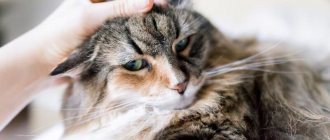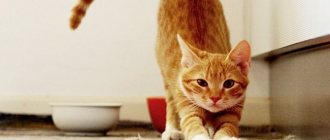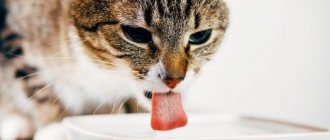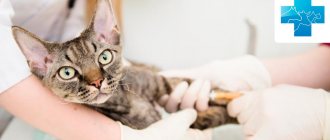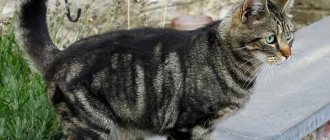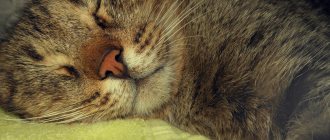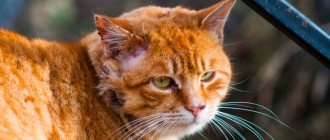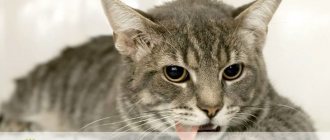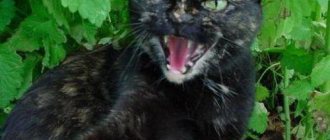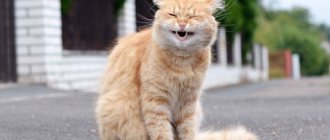Having an appetite in a pet is a sign of excellent health. If the animal feels well, it does not refuse to eat. When a cat eats poorly and loses weight, the owner begins to sound the alarm. There may be several reasons for refusal, among them are natural factors - environmental temperature, emotional states of the animal, pregnancy or the postpartum period, as well as pathologies - diseases of internal organs, stress, injuries.
It is quite problematic for the owner to independently identify the cause of food refusal and weight loss, so it is recommended to contact a veterinary clinic as soon as possible for further examinations and consultations.
The cat owner should be especially wary if there is not only a lack of appetite, but also if the animal refuses to play, changes in appearance (fur falls off, becomes unkempt), digestive disorders occur (diarrhea and vomiting), and general body temperature increases. It is necessary to sound the alarm when an animal refuses water, as this condition can lead to dehydration and even death.
Is there any cause for concern?
In fact, the fact that a cat does not eat anything or eats little does not always indicate an animal illness or other problems. All animals have fasting days, and cats are no exception. Because if:
- Refusal to eat lasts no more than 2 days.
- The cat drinks during this time.
- Activity remains at the same level or changes slightly.
- The animal reacts positively to the “sweets.”
- then there is most likely no reason to worry. As veterinarians sometimes say, “if a cat doesn’t eat and doesn’t look like it’s dying, you’re saving food.”
But the cat does not eat for several days, does not drink or drinks very little, all this is accompanied by lethargy and apathy - there is a high probability of problems, and serious ones.
Deviation or norm?
Before taking any measures, you need to make sure that the pet is really very thin. Each breed has its own average performance. For example, outbred cats weigh from 3.5 to 4.5 kg, British and Siberian breeds - from 5-7, Maine Coons - from 8 to 12.
© shutterstock
Lack of weight can be determined by palpating the animal's body. If the ribs are well felt and the fat layer is insignificant, this is a deviation from the norm. In cases where the physiological causes listed below are excluded, consultation with a doctor is required.
An alarming sign is if the cat looks thin visually, its ribs, spine and pelvic bones protrude, and there is no fat layer . The stomach is sunken, and the silhouette resembles an hourglass. Such signs indicate exhaustion of the body. A veterinary examination and serious treatment is required.
Reasons for refusing food
There may be several reasons for refusing food. Some of them are not too serious, so the intervention of the owner, and especially the veterinarian, will be unnecessary. But still, you shouldn’t ignore them either.
A cat may refuse food if:
- Changes in diet. Felines are finicky animals, so introducing new foods to the menu or switching to a new type of food is often accompanied by a “fast” for several days. In order not to exhaust the animal, the change in eating habits should be carried out gradually.
- Stress. Stress is another common cause. After moving to a new home, visiting the veterinarian, or (a nightmare!) the appearance of another pet in the house, the cat may ignore the offered food for quite a long time. Usually hunger takes its toll, but not right away!
- Oral diseases. If eating causes your pet pain or discomfort, he may simply refuse to go to the bowl. If the disease is mild, the problem usually resolves itself, but if the disease is severe, forced fasting will only worsen the problem.
- Various pathologies. Perhaps the most serious reason why a cat does not eat. It is in this case that lethargy and refusal of water are observed. Lack of appetite is observed in food poisoning, kidney and gastrointestinal diseases, cancer, endocrine problems... In any case, you cannot wait until the animal copes with the disease on its own - the lack of nutrients here acts as a factor that depresses the immune system.
Reasons why a cat doesn't eat well
In fact, you shouldn't always panic when your cat doesn't eat anything for a couple of days. Especially in cases where the animal does not look exhausted, does not have a fever, and there are no signs of an upset stomach or other malfunction of the body. The most common reasons why a cat doesn’t eat anything:
- Abrupt transition to new or unusual food.
Cats have their own taste preferences, just like people, so even high-quality food suddenly introduced into the diet can cause food refusal. The owner should always carefully study the composition of the food, the manufacturer’s recommendations for feeding and remember that the new product is introduced gradually, only mixed in small quantities with the old one that is familiar to the animal. This situation can also happen when a cat accustomed to industrial food is transferred for natural food. It is unlikely that a cat that has eaten dry food will happily eat, for example, vegetables with meat or cottage cheese. But if it’s just a matter of changing the usual diet, then there is no need to worry, the cat is simply not yet accustomed to the innovations in its menu. The animal itself does not look sick; it does not have diarrhea, vomiting, or excessive discharge from the eyes or nose. - Stressful situations.
Cats are sensitive animals; just like people, they can be sad, worried, or afraid of something. In a stressful situation, it may be quite normal to refuse food for a couple of days, feel depressed, and apathy. In this case, it would be a good idea for the owner to first try to find out what is the cause of the animal’s suffering, eliminating it if possible. If the situation cannot be corrected (the death of someone dear to the animal, the appearance of a new pet in the house, etc.), then it will take time and participation in the cat’s life on the part of the owner. You may need to consult a veterinarian, as well as purchase sedatives for purring. - Weather.
When the temperature outside the window exceeds 30 (or even 40) degrees, even the most voracious animal can look for a patch of shade on the street or lie exhausted on the floor, forgetting about food. In such cases, you should not force feed the cat and lament why it refuses to eat. On the hottest days, it is better not to overload the animal’s body, however, clean drinking water at such times is more important than ever. - The owner does not monitor the cleanliness of the animal’s bowls.
Cats are one of the cleanest animals, so the owner should wash all cat dishes after each feeding or at least once a day. Dirty plates, bowls with dried food debris, ants crowding around, and the smell of sour food can make a cat refuse to eat. In addition, neglect of cleanliness can lead to various diseases. - Hormonal surge.
When the animal's body undergoes restructuring during puberty, during estrus and pregnancy in cats, the owner may observe a refusal of food in the pet. During the period of cat spree, animals may not eat for up to a week, especially females. The owner should not worry, since the cat’s appetite will return to normal as soon as the animal calms down, and the problem of hormonal changes will be solved by itself. It may not be superfluous to purchase vitamins depending on your doctor’s recommendations. - Helminthiasis or the presence of external parasites in a cat.
The owner should remember that the presence of worms, as well as external bloodsuckers (most often fleas) can cause many problems for the animal. All parasites multiply at enormous speed, and then with their offspring they feed on the blood of the animal and poison its body with the products of their vital activity. The cat's owner should take preventive measures to ensure that the four-legged friend's body is free of worms and fleas, and also monitor the cleanliness of the room. If the owner suspects that the cat has worms, then the following symptoms will become alarming: diarrhea, cough, vomiting. Fleas can cause the following unpleasant conditions for a cat: poor sleep, thinning fur, itching from bites. - There are many pieces of fur accumulated in the cat's stomach.
In cases where an animal actively licks itself, a large amount of hair accumulates in its stomach. This problem is especially acute when the owner does not comb out the pet’s fur. Vet pharmacies sell special products that prevent the formation of hairballs, which can be purchased by the cat owner. In addition to refusal to eat, this problem is also characterized by stool disorders and vomiting. - Infection of a cat with a viral or bacterial infection.
Even a cat that lives permanently in an apartment without leaving the house has a risk of contracting an infection. The owner should be alert to the pet's lethargy, vomiting and diarrhea (sometimes with mucus and blood streaks), and elevated temperature. During an infectious infection, the animal has no appetite. By taking tests, you can identify the pathogen and decide on treatment. - Anorexia.
Anorexia in cats is considered to be a refusal to eat due to the loss of olfactory or tactile functions of the body. The cat loses weight, is not interested in absolutely any food, becomes lethargic, and sometimes salivates profusely. In the most difficult cases, the veterinarian may decide to feed the animal through a tube. The causes of anorexia can be nasal congestion, chemotherapy or antibiotic treatment, poisoning and much more. Self-treatment without medical intervention can lead to the death of the animal. - Diseases of internal organs.
You can endlessly list all sorts of diseases in which a cat may lack appetite: diabetes, malignant tumors, liver diseases, kidney diseases, problems of the gastrointestinal tract and genitourinary system, diseases of the musculoskeletal system and many, many others. If a cat, in addition to 1-2 days of fasting, has various alarming symptoms, the owner should immediately rush to consult a specialist. As a rule, with any terrible diseases, the very appearance of the cat “screams” about the disease and the following symptoms appear: intestinal dysfunction (constipation , diarrhea), vomiting, sudden weight loss, discharge from the eyes (sometimes purulent), nose, dehydration, sometimes pain upon contact with the diseased area, plaintive meowing or complete apathy to what is happening around. All these signs always indicate a serious health condition of the cat and diseases that must be diagnosed through tests, scrapings, biopsies, and examination by a veterinarian. Painful sensations will always force the cat to refuse food or eat very little.
What to do if the cat doesn't want to eat?
The optimal course of action for an owner when a cat refuses food depends on the reasons. Causing this failure:
- If changes have been made to the diet, return to the old food and gradually introduce the new one.
- When stressed, try to minimize anxiety (check with your veterinarian about the advisability of using anti-anxiety medications).
- If changes in behavior or loss of strength are observed, then the best solution would be a visit to the veterinary clinic. Only a professional examination will allow you to identify pathologies that affect appetite and draw up a treatment plan. The same should be done if the cat develops diarrhea or vomiting due to aversion to food.
Don’t forget that cats’ appetite decreases over time (although not all). Therefore, if an older cat begins to eat less, you can simply review its diet - so that even with a reduction in the volume of portions, the animal receives a sufficient amount of nutrients.
Food quality as a cause of decreased appetite in cats
Sometimes it happens that a cat’s appetite worsens due to a change in the quality of food. The cat feels well, does not show symptoms of the disease or they have been excluded by the veterinarian, but the appetite is still reduced; the pet eats, but as if with reluctance, perhaps even asks for other food. In this case, you need to pay attention to the food that the cat eats.
First, check the expiration dates on the packaging and make sure that the food is not expired. Also analyze the storage conditions - if they are violated, the food may lose its taste and even deteriorate. It must be stored in a cool place, without access to light and air, in a tightly closed container so that it does not erode.
Re-read the ingredients on the food package and try to determine if it has changed. You can use the manufacturer’s websites or online pet stores to compare the information on them with the composition on the packaging. It happens that the manufacturer changes the formula of the food, adds new ingredients to the composition or excludes something from it, reduces or increases the amount of any ingredient - cats can react to such innovations, including with a decreased appetite.
It is also important to check the organoleptic properties of the food (smell, taste, color, shape of granules). If they are not the same as the product in the previous pack or are very different, contact the store where you made the purchase, the manufacturer or distributor and try to negotiate an exchange of food or a refund.
If your cat does not eat dry food well, you can try giving it soaked: pour a small amount of food into a bowl, add a little water to it, let it sit for a while (10-15 minutes) and offer it to the cat. Not all cats agree to eat dry food in this modified form, but there are some who like it. When feeding soaked dry food, the main thing is to follow safety rules: pour in as much food as the cat will eat at a time, and do not leave it in the bowl for a long time - in hot weather, bacteria will begin to multiply in it within half an hour, and such food will become dangerous to the cat's health.
If a cat does not eat wet food well, the algorithm of actions is the same as in the case of dry food: we check expiration dates, storage conditions, organoleptic properties, changes in composition. All these factors need to be analyzed and understood what could be the reason for the deterioration of appetite. Manufacturers usually have many different flavors in their wet food lines; you can offer your cat wet food with a different flavor and watch her appetite. But do not overdo it, so as not to develop pickiness in your pet.
To make wet food more attractive to your cat, you can warm it up to 35-40 degrees (but no more) and see if the cat's reaction to warm food changes. It is also extremely important not to leave canned food in the bowl for a long time: put in as much as the animal can eat in one meal, so that the food in the bowl does not dry out and so that pathogenic bacteria do not multiply in it.
